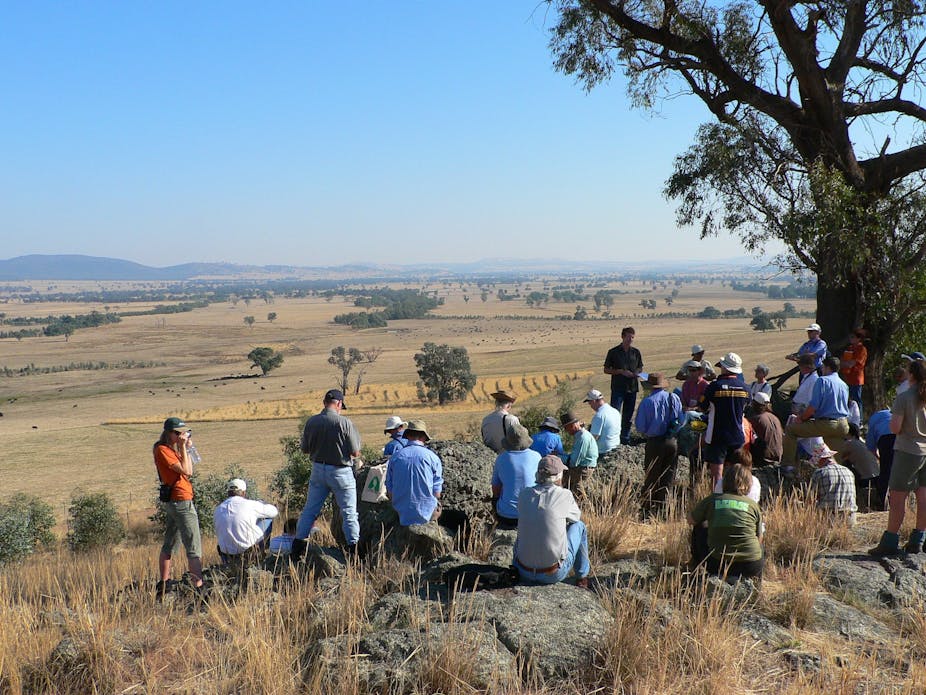Among the environmental fallout of the federal budget, Australia’s Landcare program has taken a hit, losing A$484 million. In return, the government’s environmental centrepiece, the Green Army, receives A$525 million.
But switching money from Landcare to the Green Army is trading down for a less effective conservation model. It also repeats a pattern of reduced funding and weakened delivery started under former Prime Minister John Howard, and confuses improved agricultural productivity with improved environmental management.
What is actually being cut?
Under the Coalition government, Landcare has been merged with the Caring for our Country program to form the National Landcare Program. Yet just two months ago, the government reiterated its pre-election commitment not to reduce funding for the combined programs.
So what is being cut? Mostly funding for future rounds of local project grants. These grants would have gone to community Landcare groups to do the same sort of local environmental projects that are now going to be done by the Green Army, such as revegetation, weed management and heritage protection.
Bait-and-switch is a retail trick where you advertise a product at a good price, pull the customers in, and then switch the product at the last moment for an inferior and/or more expensive version. Under the budget, the bait is Landcare, and the switch is the Green Army.
Funding that would have been gone to seasoned community volunteers, multiplying local efforts, will now go to projects done by inexperienced young people on less than the minimum wage.
No doubt many Landcare warriors would appreciate a hand from some willing young workers, but will the soldiers of the Green Army continue to maintain these projects into the future like the Landcarers would? Unlikely. They will bus in, do the project and leave.
For every dollar that government invests in Landcare, the community provides at least A$2.60 and up to A$12 of voluntary contribution in labour and materials. The soldiers of the Green Army are unlikely to be so generous. It does not make economic, environmental or social sense to displace Landcare projects with a Green Army.
The budget papers describe the Green Army as “Australia’s largest ever environmental workforce, building to 15,000 participants by 2018-19”. This claim may be news to the more than half a million members of Landcare, including 75% of broadacre and dairy farmers, and 50% of all farmers.
Governments need to be careful about white-anting the business models of existing private sector environmental contractors, and disenfranchising passionate volunteers.
Landcare is about building social capital in rural communities and helping communities to promote sustainable land and water management and more effectively tackle common problems that cross farm boundaries.
The Green Army is about providing hopefully useful environmental training and experience for under-employed young people, ideally on worthwhile tasks that would not otherwise happen.
At least these programs should be complementary, and at best they should work together, but the government appears to see them as overlapping and interchangeable.

Environmental decline since Howard
Unfortunately this budget continues a trend across successive administrations of all political stripes. Over the last 25 years, Australia has introduced innovations in environmental and natural resource management (NRM): Landcare, Waterwatch, our regional framework of Catchment Management Authorities and regional NRM bodies, innovative incentives for nature conservation on private lands, sophisticated resource allocation tools, and an outstanding National Reserves System including private and Indigenous Protected Areas.
Put together, these innovations give us the elements of a world-leading framework for managing our environment wisely across private and public lands, and for generations to come.
But we have fallen into a depressing cycle in which each change of government ridicules the approach of its predecessor; new ministers appear to think that they need new initiatives that they can “own”; new programs have to be renamed or rebadged and differentiated from their antecedents; and good people employed on previous programs need to be “let go”.
Undermining Landcare, by cutting its funding and simultaneously introducing a Green Army, merely repeats a tiresome pattern. The Rudd government’s Caring for Our Country reduced core funding for regional NRM bodies by 40% in 2008, after the Howard government’s move to a regional NRM model had already weakened Landcare in the early 2000s.
Long-term environmental problems and long-term productivity challenges in agriculture demand long-term responses, with durable core funding, complemented by enough flexibility to allow for adaptive management, without trashing the platform built by previous investments.
It is obvious that the Landcare program and the Green Army need to be coordinated – but there is no evidence of that yet.
Prioritising farms over conservation
Another apparent trend at federal, state and territory levels is the creeping subsidisation of agricultural production from environment budgets.
At the heart of Landcare has been the notion that better land management is good for productivity, and good for the environment. But better land management does not always mean more productivity, and there is much more to environmental management than agriculture.
Under the former government’s Caring for Our Country program, the view in agriculture circles was that the pendulum had swung too far towards conservation.
Now we may be seeing an over-correction. Examples are the disturbing redirection of A$10 million from the National Landcare Program to pay for drought relief for cattle farmers in Queensland and northern New South Wales, a process already started under Labor, and the restructure of Catchment Management Authorities in NSW into Local Land Services.
We need to improve agricultural productivity and environmental protection – they are not mutually exclusive. Sadly, the budget has succeeded in dismaying people interested in more sustainable management of land, water and biodiversity.

